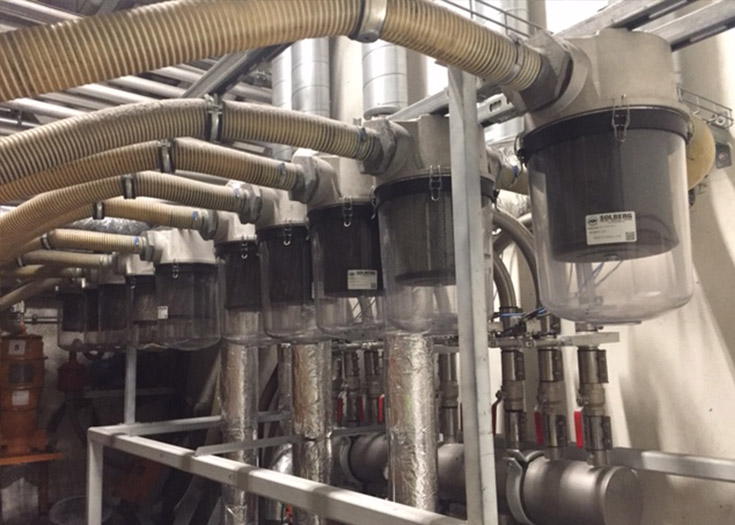
Introduction
Pneumatic conveying is an important process for many industries including plastics production & transport, food processing & packaging, and agricultural seed transport & storage to name a few. Filtration and silencing solutions are an integral part of an effective pneumatic conveying system. Duties range from protecting the air moving equipment to silencing noise emitted by the equipment. Filtration is necessary to clean atmospheric air entering the process through blower/pump intake and any air bleed valves or vacuum relief valves within the system. This article discusses the process of pneumatic conveying and the importance of filtration to the system.
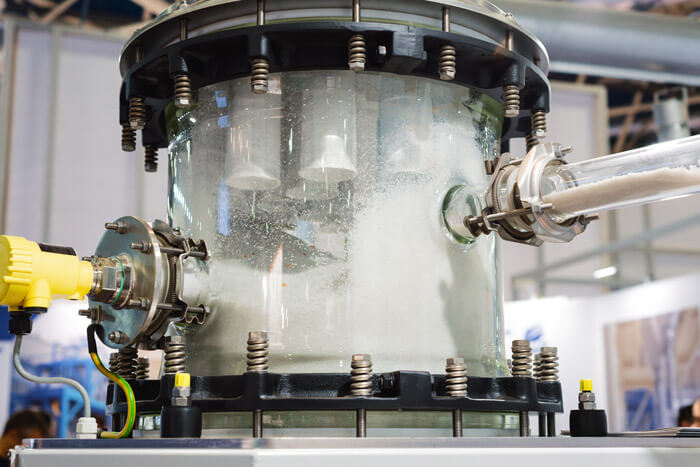
Transparent hopper and piping allows for visual confirmation that the pnuematic conveying system is operating correctly.
What is a Pneumatic Conveying System?
Pneumatic conveying is a process that uses air to transfer bulk product such as powders, pellets, and other solids from point A to point B within piping or tubing. Successful conveying of material relies upon air flow between the starting and endpoints of the system. Flow is typically achieved using a blower, compressor, fan, or vacuum pump.
Pneumatic conveying system designers and builders will consider the type of product being conveyed when selecting the most appropriate pneumatic conveying system.
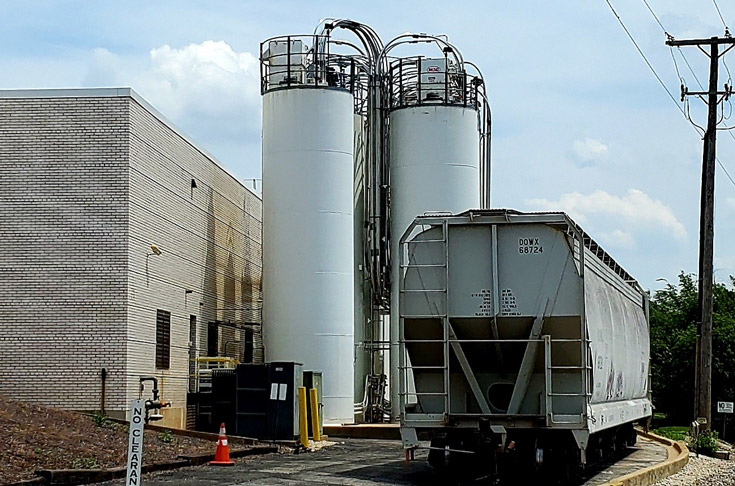
This injection molding facility uses a pneumatic conveying system to offload plastic pellets from railcars to storage and distribution silos.
Primary Conveying Types
The most common type of pneumatic conveying system is the dilute or lean phase system, in which air flow can be generated using either pressure or vacuum equipment. Operating pressures are typically less than 1 bar(g) in pressure environments, and vacuum systems typically operate around 500 mbar. These systems use high velocities to fluidize the product in the air stream.
Dense phase pneumatic conveying is applied as a method for moving heavy, fragile, or abrasive materials at slow speed. Material moves along an enclosed pipe at a low velocity. This allows for less wear and tear on both the system piping and the materials being conveyed. Therefore, dense phase is often the system of choice when materials need to be conveyed over long distances.
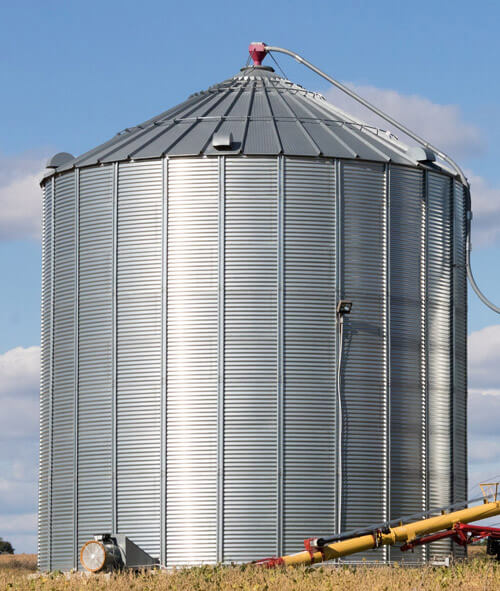
Dense phase and dilute phase pneumatic conveying are used in agricultural applications to move grains, corn, and other products into and out of storage silos.
Saltation Velocity
A common factor in the pneumatic conveying design process is the calculation of the saltation velocity. Saltation velocity is the air velocity below which the solids being conveyed start to settle at the bottom of horizontal pipe runs. This information is important to selecting the proper equipment type needed for a successful conveying system. The incorrect air moving equipment can cause damage to the products being conveyed or keep products from being conveyed altogether. To convey bulk solids such as a powder or granulates, the minimum air conveying velocity must be HIGHER than the saltation velocity.
What Types of Air Moving Equipment is Used in Pneumatic Conveying
Several types of air moving technologies are applied in pneumatic conveying applications, which will be decided by the system builder. In Positive Pressure Conveying Systems, air movement equipment types include:
Blower
• Rotary Lobe / Positive Displacement (PD), Centrifugal, Claw etc.
Compressor
• Rotary Screw, Centrifugal, Blade etc.
Fan
• Radial
In Negative Pressure (Vacuum) Conveying Systems, air moving equipment types include:
Vacuum Pump
• Rotary Vane, Claw, Liquid Ring, Side Channel, Screw, Roots Style Exhauster (PD Blower)

Pneumatic conveying equipment in a coffee production facility. System uses vacuum pumps and PD blowers for pushing and pulling the materials.
Why is Filtration Needed in Pneumatic Conveying
Without proper filtration in place, a pneumatic conveying system is at risk of diminished equipment performance including failure and process contamination that can result in increased scrap and waste costs.
Downtime of a process is both unwanted and costly. A common factor contributing to process downtime is equipment failure caused by environmental contaminants and process materials entering the air moving equipment. This can be avoided with the selection of a properly specified filtration solution.
Intake filters and filter silencers serve a crucial role in the protection of the positive pressure air moving equipment. Without a properly sized filter solution, foreign objects such as airborne dusts and particles, bugs, animals, or hardware (nuts, bolts etc.) run the risk of being drawn into the equipment. This can lead to machine failure and system downtime. The addition of a high-quality filter to clean the inlet atmospheric air and protect the blower, compressor, or fan can reduce the possibility of downtime. When noise in the surrounding environment is an issue, silencing can be integrated with the filter in a compact solution called an inlet filter silencer.
Depending on the operating conditions and equipment capabilities, a purpose specific filter media can be selected to meet the performance and removal efficiency requirements. For example, a food packaging environment may require an E12 grade High Efficiency Particulate Air Filter (HEPA) to capture 99.97% of the particulate load at or above 0.3 micron. In this scenario, filter sizing is crucial to ensure the pressure drop across the filter has a negligible impact on equipment performance.
On the process/delivery side of the positive pressure air moving equipment, there is often a call for filtration solutions in pneumatic conveying applications. These inline style filters provide protection for the process materials from foreign particles, and ensure clean air is delivered. Again, sizing is crucial to ensure that the Air Moving Equipment can operate at optimal performance levels. In the Pharmaceutical Industry, Inline Filtration is commonly specified due to the sensitive nature of the product being transferred. If contaminated, the cost of product scrappage can be extremely high. In many cases, a high efficiency filter media such as H14 grade Ultra Low Particulate Air Filter (ULPA) will be required due to the removal properties offered, 99.995% removal efficiency at 0.1 micron.
Another potential challenge to consider is the Separation of liquids that may be present between the Air Moving Equipment and the process. Some technologies use oil as the lubricating fluid and in the event of a failure, oil can migrate into the Conveying System. An Inline Oil Separator Assembly can ensure that elevated levels of oil are successfully removed from the air stream. This is achieved through multistage separation solutions that incorporate a variety of mechanical technologies including baffling, velocity and directional changes, and final stage high efficiency oil mist coalescing media pack.
In negative pressure or vacuum Conveying Systems, Filtration Solutions serve as protection for the vacuum pump. The properties and characteristics of the substance being conveyed heavily influences the selection of the appropriate filter housing style, materials of construction, and the filter media necessary to optimize performance and longevity. (i.e., plastic, cement, fly ash, flour, grain, etc.) Selecting the best filter for the job is important, and there are some factors to consider when reviewing the specifications.
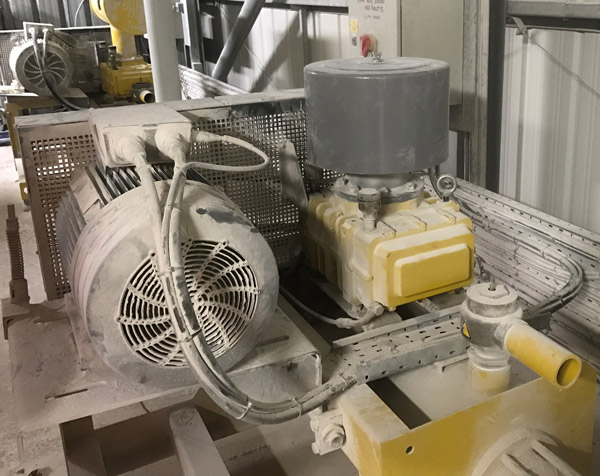
A PD blower with an inlet filter silencer protecting a cement conveying application.
For example, what is the micron size of the product being conveyed? If it is a coarse product such as plastic pellets, an industrial 5-micron efficiency polyester media is likely to be enough for the job.
What are the inbound dust load levels? In many pneumatic conveying systems, the particulate challenge to the filter can be quite significant. If the particulate load is extreme, filters can clog very quickly, leading to excessive maintenance intervals and process down time. In these scenarios, a single primary filter assembly may quickly become overwhelmed, leading to high-pressure differentials and reduced equipment performance if the filter is not properly maintained. An ideal solution in this case is a multistage filtration system with a pre-cleaner assembly to address the bulk of the dust followed by a primary particulate filter. A mechanical precleaner, such as the SM Spinmeister® series manufactured by Solberg uses an impeller to centrifugally separate particulates at 15 micron and larger from the air stream. The Spinmeister® pre-cleaner removes much of the dust and particles allowing the primary filter to operate over a longer period, extending maintenance intervals for operators.
Another specialty solution option involves a self-cleaning filter filtration system such as the RST reverse pulse series developed by Solberg. A reverse pulse system uses compressed air to purge the loaded filter element of collected dusts making it a self-cleaning filtration system. Both options help to extend primary filter life, thus extending service and maintenance intervals. The result is maximum process uptime.
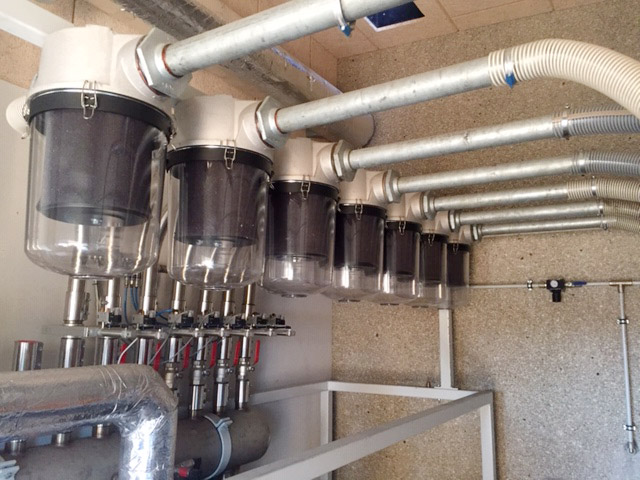
A bank of Solberg ST series protects a Pneumatic conveying system for recycled material at a plastic extrusion factory.
In high temperature applications where the gas stream is more than 100C, the filter media will need to be tailored to suit the working environment. Depending on the filtration efficiency requirements, a suitable high temperature filter media can be selected to ensure longevity. Media choices include aramid fiber, fiberglass, and woven stainless steel, among others.
If the application involves moisture, a multistage liquid separator / vacuum filter assembly is designed to handle the challenge from the process. Most vacuum pump technologies do not perform well when contaminated with liquid and therefore proper filtration & separation is important.
If the liquid challenge contains harsh chemicals or corrosive substances, the materials of construction for the filter assembly and filter element will need to be resistant. Materials suitable for corrosive environments include stainless steel, aluminum, or plastics for the housings and a variety of synthetic or metallic materials for the filter elements. Specialty coatings such as PTFE or multilayer primer and paint combinations can be applied to metal housings to improve corrosion resistance as well.
Some vacuum pump technologies such as rotary vane, rotary screw, rotary piston, and liquid ring use oil as the lubricating fluid. Under harsh operating conditions, the vacuum pump can discharge oil mist and smoke into the work environment. Although most oil sealed vacuum pump systems are equipped with an air/oil separator, sometimes a polishing filter is necessary to keep the work environment clean and free of oil mist. An external Oil Mist Eliminator that uses fiberglass oil mist coalescing technology will operate to remove the vented oily emissions from the rotating equipment. With a removal efficiency rating of 99.97% at 0.3 micron, the result is a much cleaner working environment for the operators in the facility.
Another area where filtration is important within a pneumatic conveying system is on air bleed or vacuum relief valves. When an air bleed vacuum relief valve is actuated, air enters the system and can introduce contaminants into the process air stream. Adding a filter at this air entry point provides protection for the air moving equipment and helps ensure product integrity for push-pull system designs. The filter silencer is a popular choice, as the noise attenuation features help to reduce the noise emitted from the system, which is caused by air rushing through the valve opening. Without a silencer in place, the noise can be high pitched and uncomfortable to the human ear.
Silo breather filters form an important part of the system. They act to clean the air venting from the silo which contains particulates of the product being blown into the silo. A properly sized air filter or filter silencer assembly will help minimize product discharge into the environment. As with all the filters described, sizing is a critical factor that ensures minimal restriction on the equipment it is designed to protect.
How Does Filtration Affect Filtration Performance
All filters require periodic maintenance. Without regular checks, a filter can become loaded with contaminants leading to excessive pressure drop and reduced system performance. Different filter media types may be serviced differently. Some are designed as single items i.e., most paper filter elements. Some synthetic medias like polyester may be cleaned by washing, brushing, or vacuuming to remove dust build up. It is important to implement a preventative maintenance schedule to ensure maximum process uptime.
Special Considerations
ATEX certification is often requested in pneumatic conveying applications. This is a European Union standard that seeks to minimize the possibility of explosions related to equipment operating in potentially explosive gaseous or dusty environments. Filter assemblies may require ATEX certification since they potentially act as a source of ignition due to static electricity build up. An ATEX rated filter housing is designed so that the housing, filter element, and all other components are electrically conductive, and therefore incapable of building up a static charge when properly grounded. ATEX certified filtration products undergo a strict testing regime. Name plates and documentation verifying suitable operating conditions are standard with each filter housing.
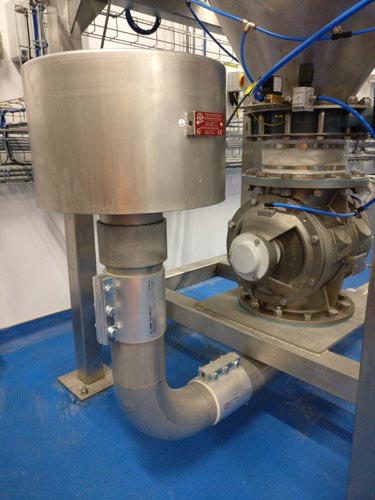
This ATEX Inlet Filter Silencer protects against contamination as an airlock feeds material into the conveying line.
Stainless steel materials of construction are often required for the filter assembly to meet specific application requirements, prevent issues with corrosion, or to minimize general wear and tear. Depending on the industry and nature of the process, the requirement ranges from 304 through 316L stainless steel. In applications where the operating environment is harsh or the nature of the conveyed product is particularly aggressive, custom coatings may be applied to the metal filter vessel to withstand the challenge, i.e., PTFE coatings, high grade epoxies, or stainless-steel paints.
In some cases where the working pressures exceed 0.5 barg (7.5 PSI), PED (Pressure Equipment Directive) or ASME Section VIII construction may be required to meet safety standards for the region. Pressure vessel standards vary by country and region, so it is important to know the local requirements when selecting filtration for the pneumatic conveying system.
Conclusion
Although there are several variables to consider when designing an effective pneumatic conveying system, one thing is constant: filtration is essential. The right filtration solutions will protect the air moving equipment and maintain purity of the product being conveyed.
Solberg Manufacturing is an industry-leading expert on all types of air and gas filters, as well as vapor traps, silencers, and replacement elements. To learn more about our filtration solutions or to place an order, please contact us through our online form, and a Solberg team member will be in touch shortly.